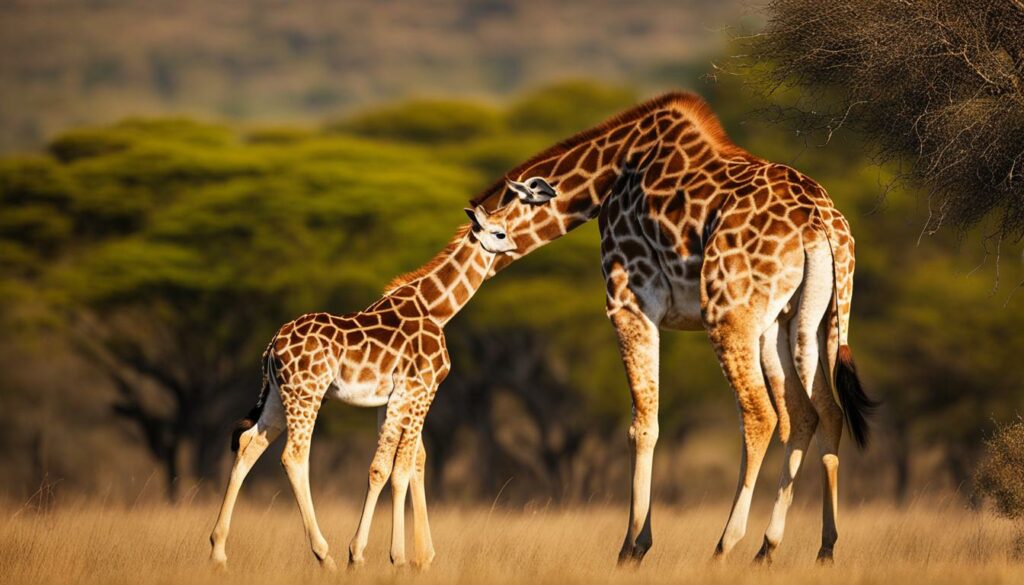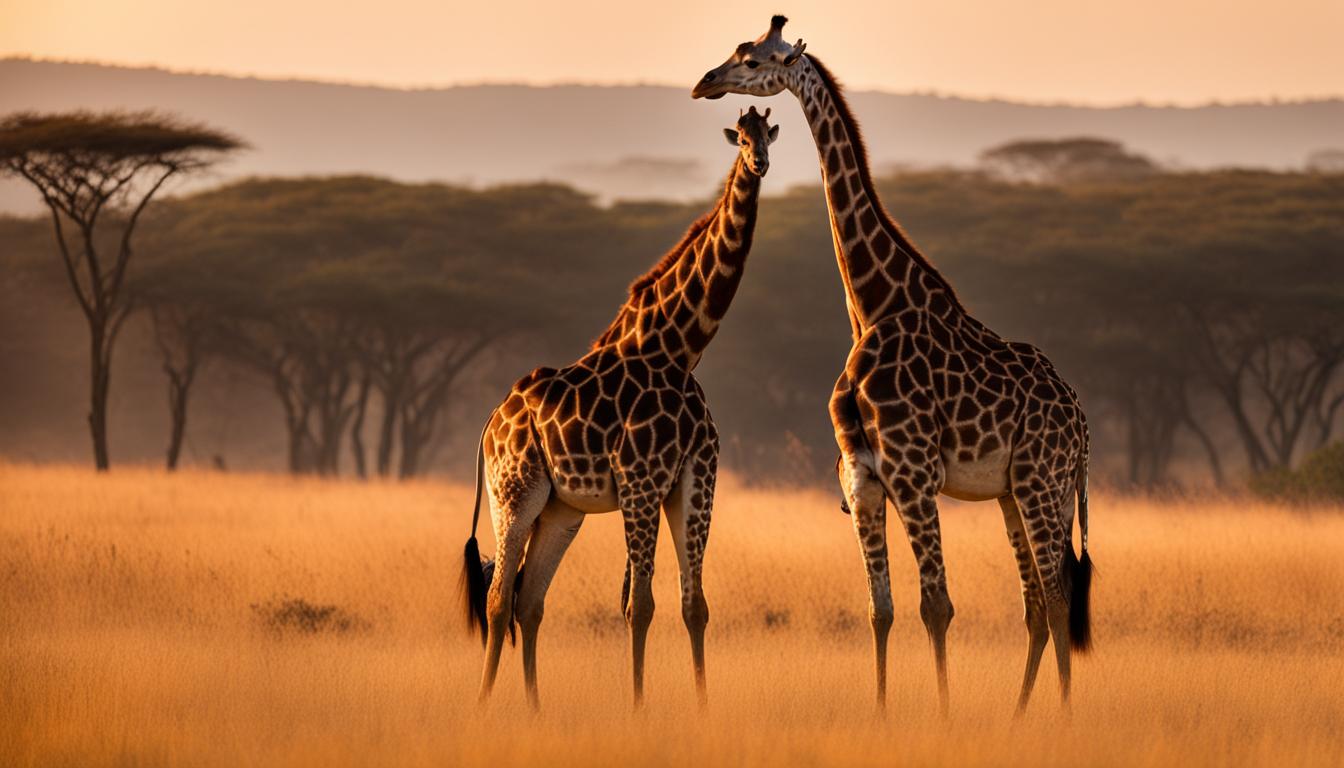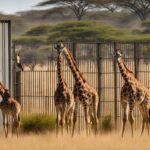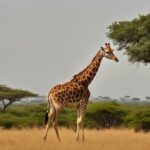Giraffes are fascinating creatures with unique reproductive systems. In this article, we will explore the captivating world of giraffe reproduction, including mating, breeding, the gestation period, and their reproductive cycle. Whether you are a curious animal lover or simply eager to learn more about these majestic animals, read on to discover the incredible details of giraffe reproduction.
When it comes to giraffe mating, they are polygamous animals. Dominant males have the opportunity to mate with all the fertile females in the herd. Female giraffes reach sexual maturity at around three or four years old, while males become ready to mate at six or seven years old.
Unlike many other animals, female giraffes go into estrus approximately every two weeks throughout the year. Males rely on their keen sense of smell to identify females that are ready to mate. Interestingly, breeding is more common during the rainy season when there is an abundance of food and lower stress levels.
The mating process itself involves the male mounting the female from behind. This act ensures successful fertilization and increases the chances of reproduction. After successful mating, a female giraffe will undergo a gestation period of approximately 15 months.
Typically, only one calf is born, although twin births can occur but are quite rare. The newborn calf is capable of walking within an hour of birth and depends on its mother’s milk for nourishment for about nine to twelve months. Solid food is gradually introduced when the calf reaches about four months old.
It’s fascinating to note that giraffes do not have a distinct mating season. Female giraffes are receptive to mating at regular intervals throughout the year, making their reproductive cycle continuous. The interval between births is approximately two years.
Giraffe reproduction is a marvelous process that highlights the unique characteristics of these graceful creatures. As we delve deeper into the topic, we will explore courtship behavior, the reproductive cycle, the role of hormones, and more. Stay tuned to uncover the secrets of giraffe reproduction and gain a deeper understanding of these remarkable beings!
Giraffe Courtship Behavior
The courtship behavior of giraffes is a fascinating aspect of their reproductive cycle. Unlike other animals that engage in elaborate rituals, giraffes have a relatively simple courtship process. When a male giraffe detects a female in estrus, he will approach her and follow her closely. This behavior is driven by the female’s hormonal signals, indicating her readiness to mate.
Once the female giraffe stands still, signaling her receptiveness, the male mounts her from behind and copulates. There are no elaborate displays or fighting between males for dominance during the courtship process, making it a relatively straightforward affair.
The simplicity of giraffe courtship behavior highlights the efficiency of their reproductive system. By minimizing energy expenditure on courtship rituals, giraffes are able to focus their efforts on successful mating and reproductive success.
Giraffe Courtship Behavior in Summary:
- Males approach and follow receptive females
- Female standing still indicates her readiness to mate
- Male mounts female from behind for copulation
- No elaborate courtship rituals or dominance fights
Understanding giraffe courtship behavior gives us insights into their reproductive strategies and the unique adaptations they have developed over time.
| Giraffe Courtship Behavior | Description |
|---|---|
| Mating Rituals | Simple approach and following by males, mounting from behind for copulation |
| Male Dominance | No significant fighting or dominance displays during courtship |
| Efficiency | Minimizes energy expenditure on courtship rituals, focusing on reproductive success |
The Giraffe Reproductive Cycle
Giraffes have a unique reproductive cycle that distinguishes them from other mammals. Unlike many species that have specific mating seasons, female giraffes experience estrus every two weeks throughout the year. This continuous cycle allows them to be receptive to mating on a regular basis, ensuring the survival of their species.
However, while estrus occurs frequently, there are certain factors that can influence the likelihood of breeding. Breeding among giraffes is more common during the rainy season when food is plentiful and stress levels are lower. The abundance of resources creates a favorable environment for mating and the subsequent successful nurturing of offspring.
The gestation period of giraffes is approximately 15 months, one of the longest among mammals. This extended period allows the calf to develop fully before birth. Typically, only one calf is born, although twin births can occur rarely. The interval between births is approximately two years, giving the mother time to nurse and care for her offspring before entering another reproductive cycle.
| Giraffe Reproductive Cycle | Duration |
|---|---|
| Estrus Cycle | Every two weeks |
| Gestation Period | Approximately 15 months |
| Interval Between Births | Approximately two years |
The giraffe reproductive cycle is a marvel of nature’s adaptability. These magnificent creatures have evolved to ensure their survival in their natural habitats. Understanding and preserving their unique reproductive process is crucial for the conservation and protection of giraffes and their populations.
Giraffe Pregnancy and Offspring
During the gestation period, which lasts around 15 months, the female giraffe undergoes various physiological changes as she carries the developing calf. The pregnancy of a giraffe is a remarkable process, considering the long duration compared to other mammals. When the time comes to give birth, the female giraffe stands up, and the calf falls from a height of about two meters to the ground. This is an incredible sight, as the newborn enters the world with a dramatic entrance.
Typically, only one calf is born at a time, although twins can occur on rare occasions. The newborn giraffe calf is already well-equipped for survival, as it is able to walk within an hour of being born. This is a crucial adaptation that helps the calf keep up with the herd and avoid predators in the challenging African savannah. Over the next few months, the calf relies solely on its mother’s milk for nutrition and growth, gradually transitioning to solid food at around four months old.
The bond between a mother giraffe and her offspring is strong, and the calf remains close to its mother for about two years, learning essential survival skills and gradually becoming more independent. Throughout this period, the calf receives guidance and protection from its mother and the other members of the herd. This familial support contributes to the calf’s development and ensures its successful transition into adulthood.

Giraffe Offspring at a Glance:
| Characteristic | Description |
|---|---|
| Number of Offspring | Typically one calf, but twins can occur rarely |
| Gestation Period | Around 15 months |
| Independence | Gradual transition over two years |
| Mobility | Able to walk within an hour of birth |
| Nutrition | Relies on mother’s milk for 9-12 months |
| Introduction to Solid Food | Starts eating solid food at around four months old |
Giraffe reproduction is a remarkable process that showcases the unique adaptations of these magnificent animals. The successful birth and development of a giraffe calf ensure the continuity of giraffe populations in their natural habitats. However, the conservation of giraffes and their reproductive habitats is crucial to protect these incredible creatures for future generations.
Giraffe Reproductive Hormones
The hormonal regulation of giraffe reproduction is still an area that requires further research. However, it is likely that giraffes, like other mammals, have a complex interplay of hormones that regulate their reproductive cycles. Two hormones that are likely involved in this process are estradiol and progesterone.
Estradiol is a form of estrogen that plays a crucial role in the estrus cycle of female giraffes. It is responsible for the development of secondary sexual characteristics and the preparation of the reproductive system for mating. Progesterone, on the other hand, is a hormone produced by the ovaries that helps support pregnancy and maintain the uterine lining.
“The hormonal regulation of giraffe reproduction is fascinating. These majestic creatures likely have intricate mechanisms involving hormones like estradiol and progesterone to regulate their reproductive cycles.”
Understanding the specific roles and interactions of these hormones in giraffe reproduction requires further investigation. Research into giraffe reproductive hormones can provide valuable insights into the physiological and behavioral patterns associated with mating and pregnancy in giraffes. This knowledge is essential for conservation efforts and the overall understanding of these beautiful creatures.
The Role of Hormones in Giraffe Reproduction
Although the precise details of hormone regulation in giraffe reproduction are not fully known, it is clear that hormones such as estradiol and progesterone play essential roles in facilitating the reproductive processes of these majestic animals. Giraffes have unique reproductive characteristics, including their polygamous mating behavior and long gestation periods, which are likely influenced by hormonal factors.
Further studies are needed to uncover the intricate mechanisms behind hormone regulation in giraffes and how it contributes to their reproductive cycles. By understanding these hormone dynamics, researchers can gain valuable insights into the reproductive strategies and adaptations of giraffes. This knowledge can aid in conservation efforts and the development of effective management plans to protect the future of these incredible creatures.
Conclusion
Giraffe reproduction is a fascinating and unique process that allows these majestic creatures to thrive in their natural habitats. From their polygamous mating behavior to their continuous reproductive cycles, giraffes have developed remarkable adaptations. Female giraffes are receptive to mating every two weeks, regardless of the season, ensuring a constant potential for reproduction.
The mating process itself is relatively simple, with males following and mounting receptive females. This behavior is mainly driven by the female’s hormonal signals, making it a natural and instinctual process. Once the female is ready, the male approaches and copulates from behind, completing the mating ritual.
The gestation period for giraffes is one of the longest among mammals, lasting around 15 months. The female gives birth standing up, and the calf falls to the ground from a height of about two meters. Typically, only one calf is born, although twins can occur rarely. The newborn calf is remarkably resilient, able to walk within hours and depend on its mother’s milk for several months.
Despite their remarkable reproductive system, giraffe populations are currently facing significant threats. Conservation efforts are crucial to protect these magnificent creatures and ensure their continued existence. By understanding giraffe reproduction and its unique characteristics, we can work towards safeguarding their habitats and preserving these iconic animals for future generations to appreciate and admire.
How does the social structure of giraffe herds and families impact their reproduction cycle?
The social structure of giraffe herds plays a crucial role in their reproduction cycle. Within a herd, there is a clear hierarchy where dominant males mate with multiple females. This ensures genetic diversity and strengthens the herd’s survival chances. Social bonds within the family unit help protect the vulnerable young from predators and provide foraging opportunities. Ultimately, the intricate social dynamics optimize the reproduction cycle of giraffes in their natural environment.
FAQ
How do giraffes reproduce, and what is their reproduction cycle?
Giraffes are polygamous animals, with dominant males mating with all the fertile females in the herd. Female giraffes reach sexual maturity at three or four years old, while males reach it at six or seven years old. Female giraffes go into estrus every two weeks throughout the year, and breeding is more common during the rainy season. The mating process involves the male mounting the female from behind. The gestation period lasts about 15 months, and usually, only one calf is born, although twins can occur rarely.
What is giraffe courtship behavior like?
Giraffes do not have elaborate courtship rituals. Males will approach a female in estrus and follow her until she stands still, indicating her readiness to mate. This behavior is mainly driven by the female’s hormonal signals. Once the female is receptive, the male mounts her from behind and copulates. Fighting between males for dominance and mating rights is rare during the courtship process.
Is there a specific mating season for giraffes?
Giraffes do not have a distinct mating season. Female giraffes go into estrus every two weeks throughout the year, but breeding is more common during the rainy season when there is plenty of food. The reproductive cycle of giraffes is continuous, with females being receptive to mating at regular intervals. The interval between births is approximately two years.
How long is the gestation period for giraffes, and how many offspring are typically born?
The gestation period for giraffes is around 15 months, one of the longest among mammals. Typically, only one calf is born, although twins can occur but are rare. The newborn calf is able to walk within an hour of birth. It depends on its mother’s milk for nine to twelve months and starts to eat solid food at about four months old. The calf remains close to its mother for about two years before becoming more independent.
What hormones are involved in giraffe reproduction?
The hormonal regulation of giraffe reproduction is not extensively studied. However, hormones such as estradiol and progesterone are likely involved in the regulation of estrus and the maintenance of pregnancy in female giraffes. Further research is needed to fully understand the hormonal mechanisms at play in giraffe reproduction.
How does giraffe reproduction contribute to their overall survival?
Giraffe reproduction is a fascinating process that involves polygamous mating, continuous reproductive cycles, and long gestation periods. This unique reproductive system allows giraffes to thrive in their natural habitats. However, giraffe populations are facing significant threats, and conservation efforts are crucial to protect these majestic creatures.










